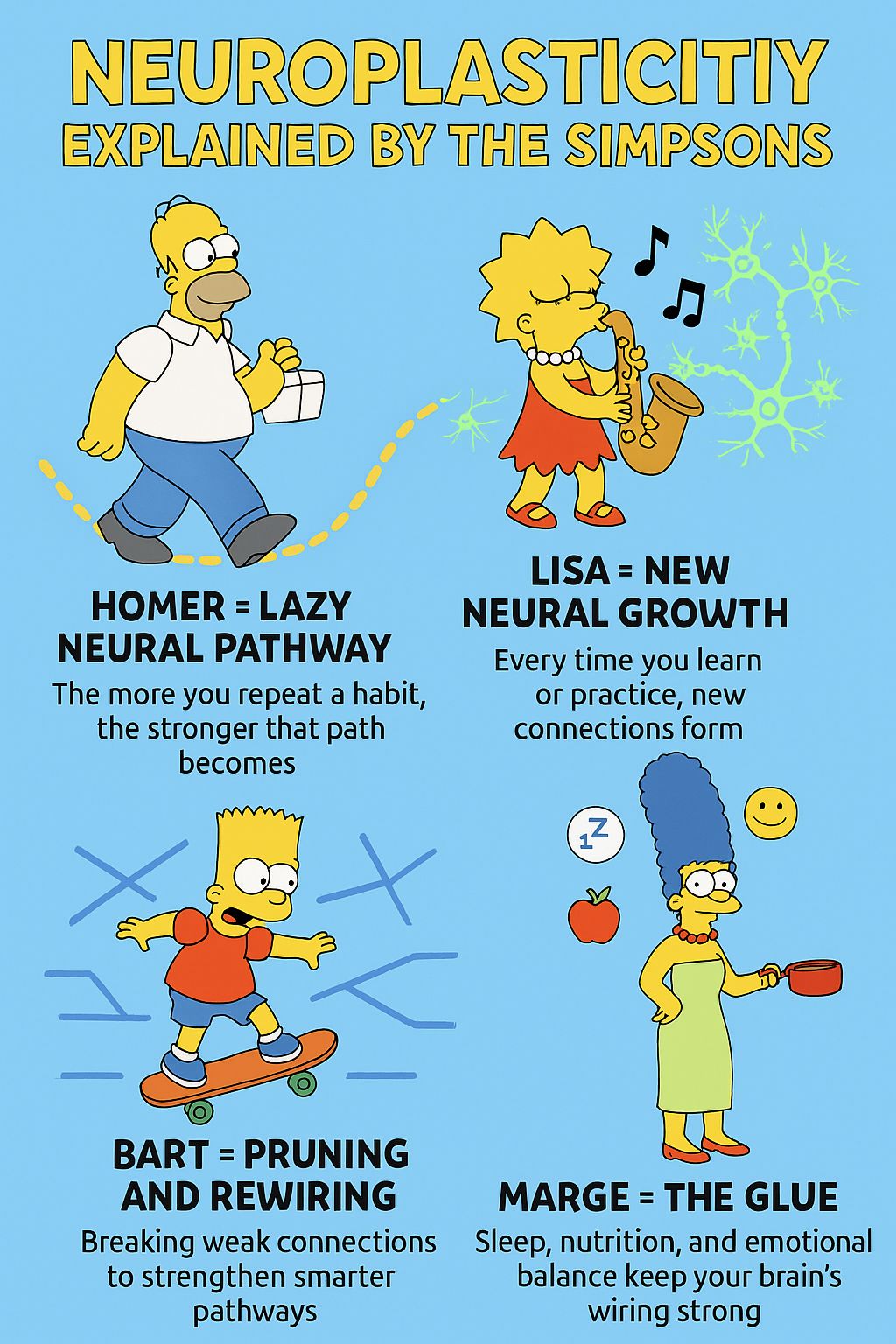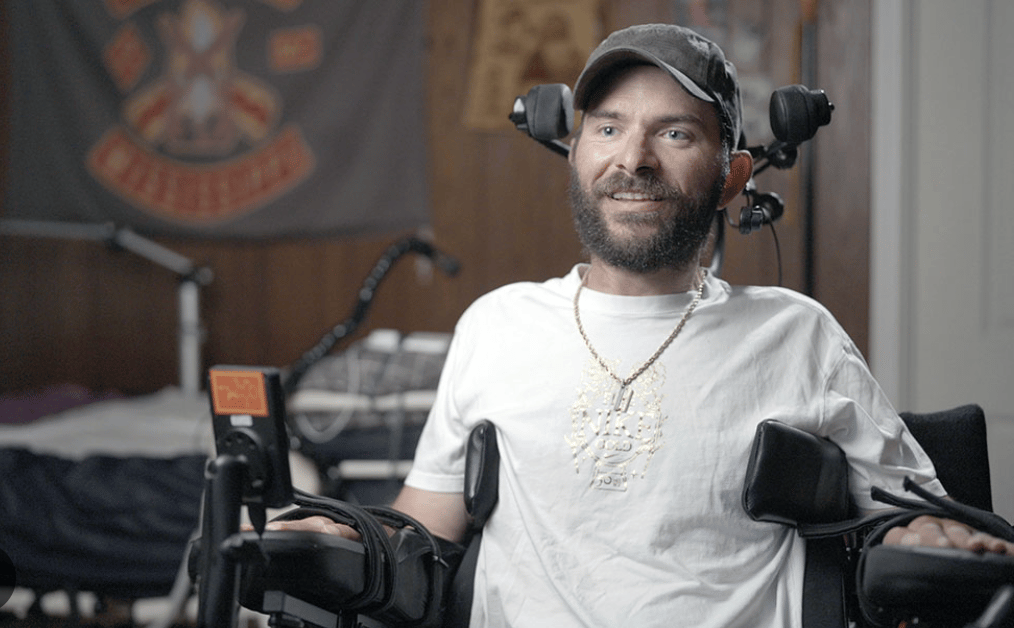- Inside Health's Newsletter
- Posts
- 🧠Neuroplasticity Edition
🧠Neuroplasticity Edition
Can You Train Your Brain to Focus?

Inside Health Weekly
The Simpsons might be able to predict the future, but you can actually shape yours, thanks to your neuroplasticity.
Welcome to “How to Rewire Your Brain 101,” a crash course on how your brain learns, adapts, and bounces back as we age.
Explore the science of neuroplasticity through the chaos of The Simpsons, because if Homer, Marge, and Lisa can rewire their brains with half a neuron between them, so can you.
This week, expect a mix of science and comedy… because laughter isn’t just memorable; it’s one of the best ways to help your brain learn.

You before reading this newsletter…
The Brain and the Simpsons
Homer = The Lazy Neural Pathway
Homer’s brain runs on autopilot: couch → fridge → repeat.
Every rerun of that routine fires the same neurons, reinforcing the same circuit. “Neurons that fire together, wire together.” Translation: Homer’s comfort zone is his brain chemistry.
Lisa = The New Neural Growth
Every saxophone practice, book, and late-night question about the universe? That’s Lisa building new synapses and growing dendritic spines.
Dendritic spines = extensions on your neurons that receive info. When you have more of them, you know more.
Synapses = how your neurons talk. More synapses = more work done.
Bart = The Eliminator
To create stronger connections, AKA remember relevant information in your life, your brain must break down old, weaker connections. This way, your brain can compensate!
When Bart actually learns, it’s because his neurons rewired themselves → out with the prank pathways, in with the smarter circuits.
Marge = The Glue
Sleep. Nutrition. Emotional balance. Without the balance of Marge, your brain’s wiring collapses faster than Homer on leg day.
Protecting your health includes your brain. Marge glues it all together.

SCIENCE BREAKDOWN: What is Neuroplasticity?
Neuroplasticity – the idea that your brain isn’t fixed.
To understand the importance of neuroplasticity, first understand how the brain works. The brain is composed of BILLIONS of neurons, and they each talk to one another. They talk to each other through electrical circuits.
This incredible network of neurons, then, changes the way they talk to one another as we experience life. Our brain connectivity grows day by day, especially depending on how we go about our days.
As we change, our brains change, too. Neuroplasticity is when our brains create new connections and literally rewires itself in response to learning, experiences, and environmental changes. What causes our brain to rewire includes:
Acquiring new skills
Adapting to new situations
Learning new ideas
Healing from an injury

So in short, neuroplasticity is the hidden player that explains why our lives are dynamic– why maybe two years ago we behaved immaturely, but now see the world differently.
The Habit Loop: Neuroplasticity in Action
Despite our lives’ purpose and sense of control, a HUGE amount of our daily behavior is driven by our habits. What forms healthy habits is underpinned by a process called The Habit Loop. It consists of 3 components:
The Cue: Something that causes the brain to engage in certain behavior
The Routine: That behavior being carried out in response to the cue
The Reward: The feeling of satisfaction that comes with following a routine
The more you perform the same behavior, the more you strengthen that neural pathway, which is a form of neuroplasticity. Consistency is neuroplasticity’s guilty pleasure that breaks old bad habits and rewires them into new, positive ones.
Watch. Read. Practice.
🎥 YouTube: TED Talk: How to Rewire Your Brain by Dr. Lara Boyd… 10 minutes that’ll completely change how you view learning.
📚 Book: The Brain That Changes Itself by Norman Doidge: real stories of people who rewired their brains after trauma or limitations.
💡 App: Lumosity: evidence-based brain training tools for focus, flexibility and memory.

ON THE MARKET: Neuralink
Neuroplasticity isn’t just about rewiring the brain… it’s rewiring markets.
At the center of this shift is Neuralink, the neurotech startup spearheading the brain–computer interface race. Once considered sci-fi, the company’s recent progress in human trials has made both Wall Street and Silicon Valley turn heads.
The Numbers Behind Neuralink:
Private valuation now exceeds $8 billion, reflecting growing investor confidence in neurotech.
Early trials show promising neural signal translation… paving the way for applications in paralysis, prosthetics, and mental health.
The global brain computer interface (BCI) market is projected to reach $7.3 billion by 2030, with Neuralink positioned as its leading innovator today.

As finals approach us, here is a list of habits backed by neuroscience that optimize focus to bag those finals!
COMING SOON! The Hormone Hack: Live Webinar
🗓 November 20th | 4–5 PM CST
RSVP Today! 👉 LIVE WEBINAR
Join us for a chance to interact with biotech CEOs, nonprofit leaders, and physicians as we unpack everything you should’ve learned about hormones, but didn’t!
A free opportunity to learn about everything from hormone health myths to health breakthroughs. Excited to dive into the science, raise awareness, and answer your most pressing questions!

💬FROM CORDELIA:
Hope you enjoyed this week’s newsletter! Here is my main takeaway:
In an age where AI is learning faster than ever, our real edge isn’t in competing with machines, it’s in adapting like the brain does. Neuroplasticity is our built in upgrade system, proof that rewiring, relearning, and reinventing aren’t just possible, they’re human. The future belongs to those who train their brains to stay curious!
That’s everything for now! Thanks for hanging out with Inside Health this week. Understanding how you function starts with education, and you’re already doing the work just by being here.
Until Next Time! —The Inside Health Team.

-Sincerely, the Inside Health Team.
